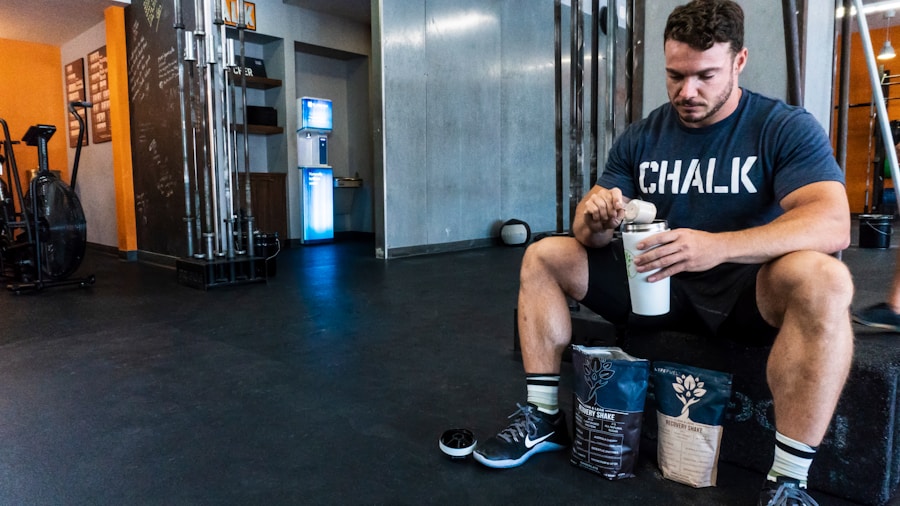Muscle growth, also known as hypertrophy, is the process by which muscle fibers increase in size. This occurs in response to resistance training, such as weightlifting, which causes microscopic damage to the muscle fibers. In response to this damage, the body initiates a series of processes that ultimately lead to muscle repair and growth. One of the key factors in muscle growth is the activation of satellite cells, which are responsible for repairing and building new muscle tissue. These cells are activated in response to mechanical stress placed on the muscles during resistance training.
Another important factor in muscle growth is the release of anabolic hormones, such as testosterone and growth hormone, which play a crucial role in stimulating protein synthesis and muscle repair. Additionally, muscle growth is also influenced by nutrition, particularly the intake of protein, which provides the building blocks necessary for muscle repair and growth. Overall, muscle growth is a complex process that involves a combination of mechanical stress, hormonal signaling, and nutritional support.
Muscle growth can be categorized into two types: myofibrillar hypertrophy and sarcoplasmic hypertrophy. Myofibrillar hypertrophy involves an increase in the size and number of myofibrils, the contractile units within muscle fibers. This type of hypertrophy is associated with increases in strength and is typically achieved through heavy resistance training. On the other hand, sarcoplasmic hypertrophy involves an increase in the volume of the sarcoplasm, the fluid within the muscle cell that contains glycogen and other energy substrates. This type of hypertrophy is associated with increases in muscle size and endurance and is typically achieved through higher rep ranges and shorter rest periods.
The Importance of Rest and Recovery in Muscle Growth
Rest and recovery are essential components of the muscle growth process. When we engage in resistance training, we create micro-tears in our muscle fibers, which then need time to repair and grow stronger. This repair process occurs during periods of rest, particularly during sleep, when the body releases anabolic hormones and initiates protein synthesis. Without adequate rest and recovery, the body does not have the opportunity to repair and rebuild muscle tissue, which can lead to overtraining and hinder muscle growth.
In addition to sleep, active recovery strategies such as foam rolling, stretching, and low-intensity exercise can also help to promote muscle recovery by increasing blood flow to the muscles and reducing muscle soreness. Nutrition also plays a crucial role in muscle recovery, as adequate protein intake is necessary to provide the building blocks for muscle repair and growth. Carbohydrates are also important for replenishing glycogen stores, which are depleted during resistance training. Overall, rest and recovery are essential for maximizing muscle growth and should be prioritized as part of a well-rounded training program.
The Role of Protein Synthesis in Muscle Growth
Protein synthesis is a key process in muscle growth, as it involves the creation of new proteins within the muscle fibers that are necessary for repair and growth. Resistance training stimulates protein synthesis by activating signaling pathways that lead to the production of new proteins. This process is regulated by a complex interplay of hormones, including insulin-like growth factor 1 (IGF-1), testosterone, and growth hormone, which all play a crucial role in stimulating protein synthesis and muscle repair.
In addition to hormonal regulation, protein synthesis is also influenced by nutrition, particularly the intake of dietary protein. Consuming adequate amounts of high-quality protein is essential for providing the amino acids necessary for protein synthesis. Leucine, in particular, has been shown to be a key regulator of protein synthesis, as it activates signaling pathways that stimulate muscle protein synthesis. Overall, protein synthesis is a fundamental process in muscle growth and is influenced by both resistance training and nutritional factors.
Understanding the Impact of Sleep on Muscle Recovery
Sleep plays a crucial role in muscle recovery and growth. During sleep, the body releases anabolic hormones such as growth hormone and testosterone, which are essential for stimulating protein synthesis and muscle repair. In addition to hormonal regulation, sleep also allows for increased blood flow to the muscles, which delivers oxygen and nutrients necessary for muscle recovery. Furthermore, sleep is when the body undergoes cellular repair and regeneration processes that are essential for overall health and well-being.
Inadequate sleep can have detrimental effects on muscle recovery and growth. Research has shown that sleep deprivation can lead to decreases in testosterone levels, increases in cortisol levels (a catabolic hormone that can break down muscle tissue), and impaired glucose metabolism, all of which can hinder muscle recovery and growth. Additionally, poor sleep quality has been associated with increased levels of inflammation, which can further impair muscle recovery. Therefore, prioritizing adequate sleep is essential for maximizing muscle growth and overall physical performance.
The Effects of Overtraining on Muscle Growth
Overtraining occurs when the body is subjected to excessive amounts of physical stress without adequate rest and recovery. This can lead to a state of chronic fatigue, decreased performance, and impaired muscle recovery. Overtraining can have detrimental effects on muscle growth, as it can lead to decreases in protein synthesis, increases in catabolic hormone levels, and overall hindered muscle repair processes.
In addition to physiological effects, overtraining can also have psychological effects such as mood disturbances, irritability, and decreased motivation. It is important to recognize the signs of overtraining, which can include persistent fatigue, decreased performance, increased resting heart rate, and mood disturbances. To prevent overtraining, it is important to prioritize rest and recovery as part of a well-rounded training program. This may include incorporating rest days into your training schedule, practicing active recovery strategies such as foam rolling and stretching, and ensuring adequate nutrition and sleep.
Strategies for Optimizing Rest and Recovery for Muscle Growth
There are several strategies that can be implemented to optimize rest and recovery for maximum muscle growth. One key strategy is to prioritize sleep by aiming for 7-9 hours of quality sleep each night. This may involve establishing a consistent sleep schedule, creating a relaxing bedtime routine, and minimizing exposure to electronic devices before bed. Additionally, incorporating active recovery strategies such as foam rolling, stretching, and low-intensity exercise can help to promote blood flow to the muscles and reduce muscle soreness.
Nutrition also plays a crucial role in optimizing rest and recovery for muscle growth. Consuming an adequate amount of high-quality protein is essential for providing the amino acids necessary for muscle repair and growth. Carbohydrates are also important for replenishing glycogen stores that are depleted during resistance training. Hydration is another important factor in muscle recovery, as adequate fluid intake is necessary for maintaining optimal cellular function and promoting nutrient delivery to the muscles.
In conclusion, balancing exercise with rest and recovery is essential for maximizing muscle growth. Understanding the basics of muscle growth, the importance of rest and recovery, the role of protein synthesis, the impact of sleep on muscle recovery, the effects of overtraining, and strategies for optimizing rest and recovery are all crucial components of a well-rounded training program. By prioritizing rest and recovery alongside resistance training and proper nutrition, individuals can optimize their potential for muscle growth and overall physical performance.





